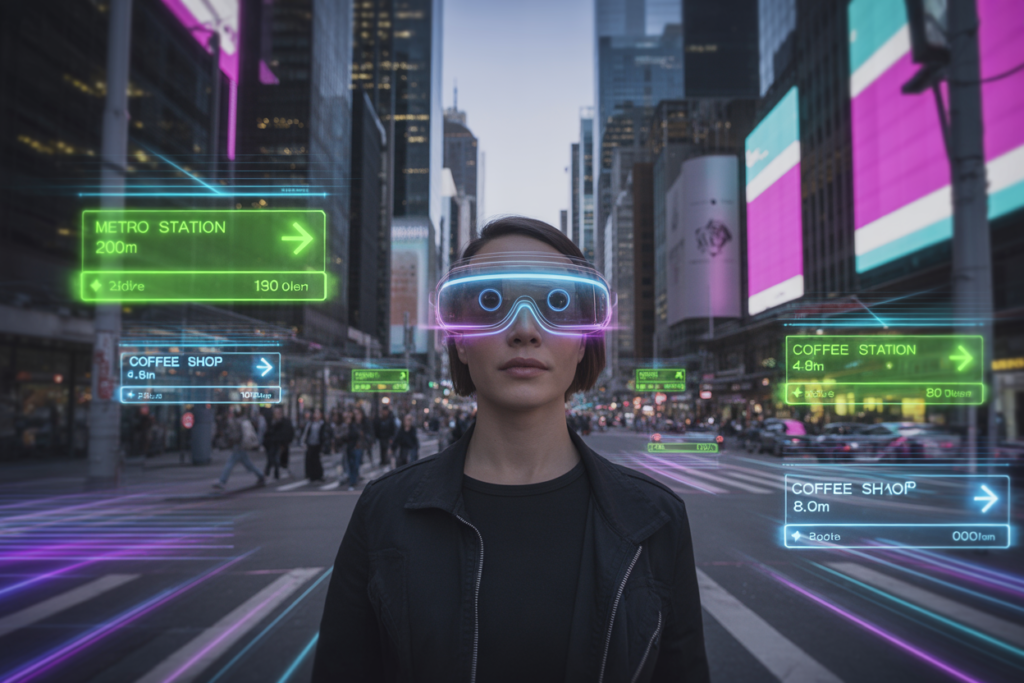Augmented Reality Devices: Transforming Perception and Interaction
Introduction
Augmented Reality (AR) devices are revolutionizing how we interact with the world by overlaying digital information onto our physical environment. Unlike virtual reality (VR), which immerses users in a fully digital world, AR enhances reality with real-time data, holograms, and interactive elements. From smart glasses to mobile AR apps, advancements in AR technology are reshaping industries like gaming, healthcare, education, and retail. By 2025, the global AR market is projected to reach $198 billion, according to Statista, driven by breakthroughs in hardware, software, and connectivity. This article explores the latest innovations in AR devices, their applications, challenges, and the future they promise, while addressing societal and ethical implications.
The Fundamentals of Augmented Reality
What is Augmented Reality?
Augmented Reality blends digital content—such as images, text, or 3D models—with the physical world, typically viewed through devices like smartphones, tablets, smart glasses, or headsets. AR devices use cameras, sensors, and displays to track the environment and project digital overlays in real-time. Key components include:
- Sensors: Cameras, gyroscopes, and accelerometers track user movement and surroundings.
- Displays: Transparent screens or retinal projectors render digital content.
- Processing Units: Powerful chips process AR data, often integrated with AI for object recognition.
- Connectivity: 5G and Wi-Fi enable seamless data streaming for cloud-based AR.
The Evolution of AR Devices
AR’s origins trace back to the 1960s with Ivan Sutherland’s head-mounted display, but practical AR emerged in the 2010s with mobile apps like Pokémon GO. By 2025, AR devices have evolved from bulky prototypes to sleek, consumer-friendly wearables. Advancements in optics, AI, and miniaturization have made AR accessible, with companies like Apple, Meta, and Microsoft leading the charge.
Major Advancements in AR Devices
1. Next-Generation AR Smart Glasses
AR smart glasses are the pinnacle of AR innovation, offering hands-free, immersive experiences. In 2024, Apple’s Vision Pro and Meta’s Orion glasses set new standards with lightweight designs, high-resolution micro-OLED displays, and advanced eye-tracking. These devices integrate spatial computing, allowing users to interact with digital objects via gestures and voice commands. Snap’s Spectacles 5, launched in 2025, introduced AR for social media, enabling real-time filters and holographic avatars.
Applications:
- Productivity: AR glasses display virtual desktops, enhancing remote work and multitasking.
- Gaming: Immersive AR games blend digital characters with real environments.
- Navigation: Real-time directions and points of interest are overlaid onto the user’s field of view.

2. Mobile AR and Software Ecosystems
Smartphones remain the most accessible AR platform, with apps leveraging powerful cameras and processors. In 2025, Google’s ARCore and Apple’s ARKit support advanced features like 3D mapping, occlusion, and motion tracking. Apps like IKEA Place allow users to visualize furniture in their homes, while Snapchat’s AR lenses generate billions of daily interactions. Cloud-based AR, powered by 5G, offloads processing to servers, enabling complex experiences on budget devices.
Impact:
- Accessibility: Mobile AR democratizes access, requiring only a smartphone.
- E-Commerce: Virtual try-ons for clothes, makeup, and furniture boost online sales.
- Education: AR apps visualize complex concepts, like anatomy or historical events.
Case Study: In 2024, Walmart integrated AR into its app, allowing customers to preview products in their homes, increasing conversion rates by 20%.
3. AR Headsets for Enterprise
AR headsets, like Microsoft’s HoloLens 3 and Magic Leap 2, are designed for industrial and professional use. In 2025, these devices feature wider fields of view (FOV), improved battery life, and AI-driven object recognition. They support complex tasks like remote maintenance, surgical guidance, and architectural design.
Applications:
- Manufacturing: AR headsets guide workers through assembly processes, reducing errors by 30%.
- Healthcare: Surgeons use AR to visualize patient anatomy during procedures.
- Training: AR simulates hazardous environments for safe, immersive training.

4. Advances in AR Optics and Displays
Optical advancements are critical to AR’s evolution. Waveguide optics, used in devices like Nreal Air, create thin, lightweight lenses that project high-resolution images. In 2024, Lumus introduced reflective waveguides with a 50-degree FOV, improving immersion. Retinal projection, explored by Mojo Vision, beams images directly onto the retina, eliminating the need for bulky screens.
Impact:
- Comfort: Lightweight optics make AR devices wearable for extended periods.
- Clarity: High-resolution displays enhance realism and readability.
- Cost Reduction: Simplified optics lower production costs, making AR more affordable.
5. Integration with AI and 5G
AI and 5G are supercharging AR devices. AI enables real-time object recognition, scene understanding, and personalized content. For example, Google’s Visual Positioning System (VPS) uses AI to map environments with centimeter-level accuracy. 5G’s low latency and high bandwidth support cloud-based AR, reducing device processing demands. In 2025, Verizon’s 5G edge network enabled AR training modules for first responders, delivering real-time simulations.
Applications:
- Personalization: AI tailors AR content based on user preferences and context.
- Collaboration: 5G enables multi-user AR experiences, like virtual meetings.
- Real-Time Analytics: AR devices process live data for sports, retail, and logistics.
6. Wearable AR Contact Lenses
Though still experimental, AR contact lenses are an emerging frontier. In 2024, Mojo Vision demonstrated a prototype lens with a micro-LED display, capable of projecting basic information like fitness stats or notifications. These lenses use biosensors to monitor health metrics, integrating seamlessly with wearables.
Potential:
- Discreet AR: Lenses offer invisible augmentation, ideal for daily use.
- Health Monitoring: Real-time data on glucose levels or heart rate.
- Military Applications: Enhanced situational awareness for soldiers.
Applications of AR Devices
1. Gaming and Entertainment
AR gaming blends digital and physical worlds, creating immersive experiences. Pokémon GO’s success paved the way for titles like Niantic’s Peridot and Microsoft’s Minecraft Earth. In 2025, AR glasses enable multiplayer games where players interact with holographic characters in real environments. AR also enhances live events, with fans using AR apps to view stats or replays during sports matches.
2. Healthcare
AR devices are transforming healthcare by improving diagnostics, training, and patient care. Surgeons use AR headsets to overlay CT scans during operations, increasing precision. In 2024, a Stanford hospital used HoloLens 3 for minimally invasive surgeries, reducing recovery times by 15%. AR also supports medical education, allowing students to visualize anatomy in 3D.
3. Education and Training
AR enhances learning by making abstract concepts tangible. In 2025, Google’s AR Expeditions app enabled students to explore virtual ecosystems, boosting engagement by 25%. In corporate settings, AR training simulates real-world scenarios, from flight simulations to retail customer service, reducing training costs.

4. Retail and E-Commerce
AR revolutionizes shopping by enabling virtual try-ons and product previews. In 2025, Amazon’s AR View app allowed customers to visualize furniture and electronics in their homes, increasing sales by 18%. Beauty brands like L’Oréal use AR for virtual makeup trials, enhancing customer confidence.
5. Architecture and Design
Architects use AR to visualize building designs on-site, overlaying 3D models onto physical spaces. In 2024, Autodesk’s AR tools helped architects detect design flaws before construction, saving 10% on project costs. AR also supports interior design, allowing clients to preview decor options.
Challenges in AR Device Development
1. Hardware Limitations
- Battery Life: AR devices require significant power for displays and sensors, limiting usage time. Current glasses offer 4-6 hours of battery life.
- Form Factor: Bulky designs deter mainstream adoption; lightweight, stylish options are needed.
- Cost: High-end AR devices like Vision Pro cost $3,500, limiting accessibility.
2. Privacy and Security
AR devices collect vast amounts of data, including camera feeds and location information, raising privacy concerns. In 2024, a data breach in an AR app exposed user locations, prompting calls for stricter regulations. Ensuring secure data processing and user consent is critical.
3. User Experience
- Motion Sickness: Prolonged AR use can cause discomfort due to latency or FOV limitations.
- Learning Curve: Complex interfaces may alienate non-tech-savvy users.
- Content Gaps: Limited AR content hinders adoption; developers need robust ecosystems.
4. Health and Social Concerns
Extended AR use may strain eyes or disrupt social interactions. Public skepticism about AR’s impact on mental health, similar to smartphone addiction concerns, persists. Ethical design practices, like limiting screen time, are essential.
The Future of AR Devices
1. Mainstream Adoption
By 2030, AR glasses are expected to replace smartphones as the primary computing platform, according to Gartner. Affordable models under $500 will drive mass adoption. Integration with AI assistants, like an advanced version of Grok, will make AR devices intuitive and indispensable.
2. Advanced AR Ecosystems
AR ecosystems will expand with open-source platforms like Unity and Unreal Engine, enabling developers to create diverse applications. Cloud-based AR, powered by 6G, will support seamless, high-fidelity experiences by 2035.
3. Convergence with Other Technologies
AR will integrate with AI, IoT, and quantum computing. For example, quantum-enhanced AR could process complex simulations in real-time, while IoT integration will create smart environments where AR devices interact with connected objects.
Prediction: By 2030, the AR market is projected to exceed $300 billion, with healthcare and gaming as leading sectors, according to PwC.
Societal Implications
AR devices have the potential to:
- Enhance Accessibility: Provide real-time translations and accessibility aids for the visually impaired.
- Drive Economic Growth: Create jobs in AR development, content creation, and hardware manufacturing.
- Transform Education: Democratize learning through immersive, interactive experiences.
However, equitable access is crucial to avoid widening digital divides. Ethical considerations, like data privacy and user well-being, must guide AR’s development.
Conclusion
Augmented Reality devices are redefining how we perceive and interact with the world, from smart glasses that enhance productivity to headsets that revolutionize industries. Advancements in optics, AI, and 5G are making AR more immersive and accessible, while applications in gaming, healthcare, and education showcase its versatility. Despite challenges like cost and privacy, the future of AR is bright, promising a seamless blend of digital and physical realities. As technology evolves, collaboration between innovators, regulators, and society will ensure AR’s transformative potential is realized responsibly.


